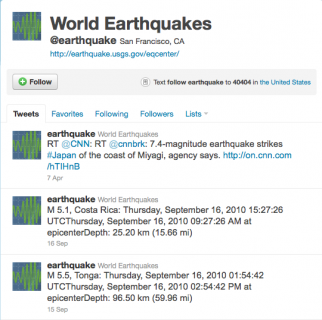
Here is Part 2 of my talk with Carol Dunn, who works for Bellevue’s Office of Emergency Management, about earthquakes and the Puget Sound. Here, Carol describes a few obstacles to convincing the community in and around Bellevue to pay attention to the earthquake threat the region faces. And, explains why social media helps preparedness.
Who are the easiest groups and/or types of companies to convince of the threat and then take action for preparedness?
Most of the groups that are the easiest to encourage to take steps to be ready for earthquakes are groups that usually do pretty well in disasters—being open to reducing risks from disasters already puts you way ahead—they are already gathering supplies, getting to know their neighbors, being sure they have the right insurance. The people who get hit hardest by disasters usually are the ones that are taken by surprise. These groups, I’ve found, are the hardest to reach out to, hardest to explain that it really is worthwhile and not as hard as it seems to simply get a list of key contact numbers so you can communicate with your loved ones, to slowly build up a back-up supply of non-perishable food, to move or secure the objects in your house that can hurt someone if it falls.
The fact is, the way our minds work, unless you have experienced a scare, you have to be pretty comfortable in your life and community for your mind to decide it is a great time to reduce future risks. If you have multiple challenges in front of you, your mind is going to work even harder to push away thoughts of future risk—it isn’t going to feel as if it is something you should do—you may want to do it, but when you start, you feel dread in the pit of your stomach, so you push it away. That is the subconscious saying that you need to have current issues or social issues be your main priority. Your subconscious means well, but it is wrong. We live where the biggest earthquakes on earth have happened before and will be happening again—it is vital to learn how to remove your subconscious from the discussion—deep down inside, we all know it doesn’t make sense not to take steps to be ready for earthquakes—it doesn’t, just do it.
 Can social media help outreach and awareness efforts? Or is Farmville-ing and tweeting about celebrities a distraction? I have visions of a big quake knocking out power and people unable to function once their smart phone and laptop batteries die.
Can social media help outreach and awareness efforts? Or is Farmville-ing and tweeting about celebrities a distraction? I have visions of a big quake knocking out power and people unable to function once their smart phone and laptop batteries die.
Social media is the greatest thing to ever happen to emergency preparedness and emergency response. Farmville-ing and tweeting and obsessing on celebrities are all coping mechanisms to balance the stress and help us move from being stressed out to being relaxed—pretty harmless ones as well. People on Facebook, people on Twitter—they are connected to a lot of really good information sources. Today they are tweeting about a celebrity, if they are in an earthquake, they will not be tweeting about Bieber, they will be able to send a single text message and have it reach their hundreds of followers. They will be able to get information on where help is located, and send information about what help is needed. Actually, there was a study that found that people who played Tetris after viewing disturbing images experienced less trauma—playing games like that may work to disrupt our mind’s ability to lay down traumatic emotional memories and reduce the risk of long term trauma, so maybe a little Farmville can be a good thing in a disaster.
It seems to me that in your job there’s a real danger of coming across to people as a worrywort or a scold when you warn about earthquakes. How do you find a strategy that communicates the need to prepare but doesn’t provoke people to bury their heads in the sand?
There is a biological reason for not preparing, for not taking future risk seriously—experiencing push-back comes with the job. When I give a presentation I start by talking about our minds. I explain why we don’t prepare, but how this means that we walk blindly into dangerous pit after dangerous pit that are just right out in front of us. Learn to see the pits, you are amazed it is so easy to just walk around them without falling in. I help people identify what risks we have in our area, and how to reduce the risks. Identify what resources we have in our area, and how to increase them. The most important message I have is that we are our own best resource. Each of us has the ability to get through the next earthquake—and to be ready to reach out and help others when it happens.
This is Part 2 in three-part series. Part 1 is here.